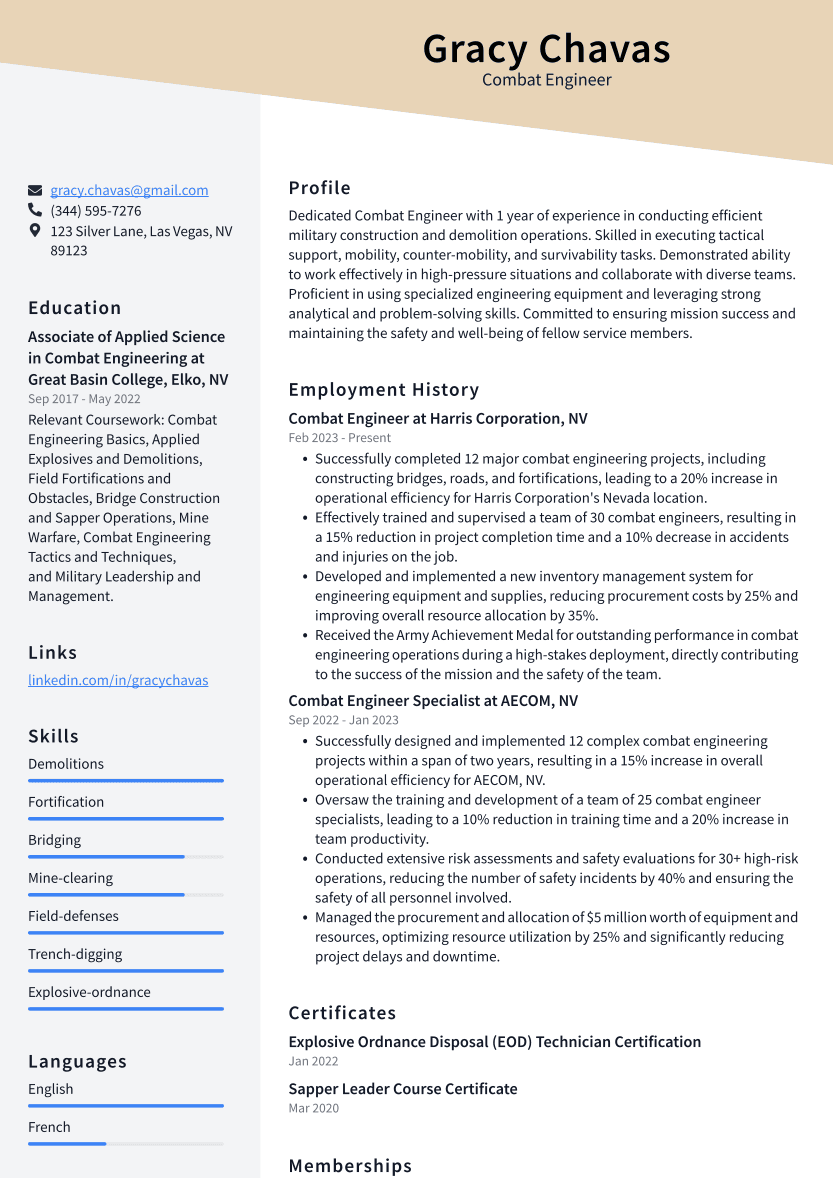Combat Engineer Resume Examples
Writing a great combat engineer resume is important because it is one of the first things a potential employer will see when they are considering you for a position. It is your opportunity to make a good first impression and sell yourself as the best candidate for the job.
Create your resume
Select from 7 professional resume templates
If you're looking for inspiration when it comes to drafting your own combat engineer resume, look no further than the samples below. These resumes will help you highlight your experience and qualifications in the most effective way possible, giving you the best chance of landing the combat engineer job you're after.
Essential Components of a Combat Engineer Resume
A Combat Engineer Resume must effectively showcase the distinctive skills, experiences, and qualifications pertinent to military engineering roles. It is crucial for the resume to highlight proficiency in construction, demolition, explosives handling, and other vital engineering tasks in combat scenarios.
Understanding the nuances of a Combat Engineer Resume is critical due to its specialized content, which differs from civilian resumes. Let's delve into the various sections of the resume, discussing their significance and content, and provide guidance on optimizing each section for maximum impact.
1. Contact Information
The contact information on your resume is a fundamental element, ensuring that potential employers can easily reach you. It typically includes your name, address, phone number, and professional email address.

- Full Name: Prominently display your name at the top of the resume, using larger or bold font to make it stand out.
- Address: Include your current address. If you're open to relocation, mention this in your cover letter rather than on the resume.
- Phone Number: Provide a reliable phone number where you can consistently be reached.
- Email Address: Use a professional email address, ideally incorporating your name for easy identification.
- LinkedIn Profile (optional): If you have a LinkedIn profile that further details your capabilities as a combat engineer, include the URL in your contact information.
Ensure all contact details are accurate to avoid missing out on potential job opportunities. Voicemail messages should also be professional in tone.
Correct contact information is vital for seamless communication with potential employers throughout the hiring process.
2. Objective Statement
The "Objective Statement" is a concise declaration of your career aspirations and how they align with the job you're applying for. It should be tailored to the role and reflect your experience in military engineering tasks such as construction, demolition, and combat preparation.
An example of an effective objective statement might be: "Combat Engineer with 5 years of experience seeking a challenging role where I can apply my expertise in construction, demolition, and strategic planning to support mission objectives."
Your objective statement should resonate with the employer's needs, demonstrating how you can contribute to their team.
Related: Top Combat Engineer Resume Objective Examples
3. Skills and Competencies
The "Skills and Abilities" section is a showcase of your unique talents that qualify you for the combat engineer role. Highlight technical skills, physical fitness, problem-solving, leadership, communication, attention to detail, military protocol knowledge, adaptability, risk management, and basic computer skills.
Illustrate these skills with examples from your experience whenever possible.
Related: Combat Engineer Skills: Definition and Examples
4. Work Experience
Your work experience is a testament to your practical application of theoretical knowledge. Detail your roles and responsibilities, emphasizing your talents, capabilities, and achievements, particularly in military engineering contexts.
List your positions in reverse chronological order, providing job titles, organization names, locations, dates of employment, and a brief description of your duties and successes.
Use action verbs and quantify achievements where possible to strengthen your statements.
Be truthful in this section to maintain credibility and avoid potential repercussions.
5. Education and Training
The "Education and Training" section should highlight your formal education, military training, certifications, and any specialized courses relevant to the combat engineer role.
- Formal Education: Include any higher education in engineering or related fields.
- Military Training: Detail your Basic Combat Training and Advanced Individual Training, focusing on the skills acquired.
- Certifications: List any certifications that enhance your qualifications as a combat engineer.
- Specialized Courses: Mention additional courses or workshops that have contributed to your expertise.
- Continuous Learning: If you're engaged in ongoing education, include this information to demonstrate your commitment to professional development.
This section should not only list your qualifications but also illustrate how they prepare you for the demands of a combat engineer role.
6. Certifications and Licenses
The "Certifications and Licenses" section validates your specialized skills and adherence to industry standards. Include relevant certifications such as Engineer-in-Training (EIT), Certified Construction Manager (CCM), Professional Engineer (PE), Project Management Professional (PMP), and any OSHA certifications.
This section underscores your commitment to professional growth and compliance with industry best practices.
Related: Combat Engineer Certifications
7. References
The "References" section can influence an employer's decision by providing contacts who can attest to your skills, work history, and character.
Select references who are familiar with your technical abilities, leadership, problem-solving, and adaptability. Ensure they are informed about the job you're applying for and willing to provide a positive endorsement.
Include the reference's name, title, professional relationship, phone number, and email address, ensuring the information is up-to-date.
While it's common to omit references from resumes for privacy reasons, be prepared to provide them upon request.
References are an integral part of your resume, offering tangible evidence of your capabilities as a combat engineer.
